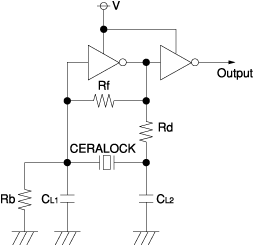Each circuit value has the following role:

Rf: Feedback resistor
The feedback resistor determines the bias of the oscillation circuit. Generally, C-MOS IC uses 100k ohms to 10M ohms (normally, 1M ohms) feedback resistance, while TTL IC uses 1k ohms to 10k ohms (normally, 4.7k ohms) feedback resistance because of low I/O impedance. If the feedback resistance is too large, the amount of feedback will be reduced, making the operating point unstable. If the feedback resistance is too small, the gain will be reduced, or the current will be increased (Recently, most ICs intgrates the feedback resistor).
Rd: Damping resistor
Damping resistor and loading capacitors work as low-passfilter that can suppress abnormal harmonic oscillation by reducing the gain in the high frequency range. Also, the IC gain can be limited and CERALOCK properly match IC, unwanted ringing, overshoot and undershoot can be suppressed. In the kHz band, the damping resistance should be several kilo-ohms, and in the MHz band, it should be between tens ohms and hundreds ohms. The damping resistor is optional.
CL1/CL2: Loading capacitor
This parameter is the most important for determining the stability of the oscillation circuit. If the load capacitance is too small, the oscillating waveform will be distorted, resulting in unstable oscillation. If it is too large, oscillation may stop. When compared with the same IC, the oscillation circuit providing lower frequency needs larger capacitance.
Rb: Bias resistor
When the IC gain is too high, or when TTL or triple-stage buffered IC is used, the bias resistor can be used to change the bias point intentionally in order to reduce the IC gain or suppress unstable oscillation. C-MOS IC uses a bias resistor of 1M ohms to 10M ohms, while TTL uses a bias resistor of several kilo-ohms to 10 kilo-ohms.
Each constant varies depending on the IC and the CERALOCK being used. For details, contact Murata.